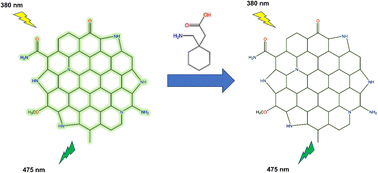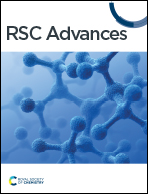Efficient and eco-friendly detection of gabapentin using nitrogen-doped carbon quantum dots: an analytical and green chemistry approach†
Abstract
This study presents the development of an eco-friendly and highly selective mitrogen-doped carbon quantum dot based sensor (N-CQDs) for the detection of gabapentin – a commonly misused drug. A detailed characterization of N-CQDs spectral features and their interaction with gabapentin is provided. The optimal conditions for sensing, including pH value, buffer volume, N-CQDs concentration, and incubation time, were established. The results showed excellent fluorescence quenching at 475 nm (λex = 380 nm) due to the dynamic quenching mechanism, and the sensor demonstrated excellent linearity in the 0.5–8.0 μg mL−1 concentration range with correlation coefficients of more than 0.999, a limit of detection (LOD) of 0.160 and limit of quantification (LOQ) of 0.480 μg mL−1. The accuracy of the proposed sensor was acceptable with a mean accuracy of 99.91 for gabapentin detection. In addition, precision values were within the acceptable range, with RSD% below 2% indicating good repeatability and reproducibility of the sensor. Selectivity was validated using common excipients and pooled plasma samples. The proposed sensor accurately estimated gabapentin concentration in commercial pharmaceutical formulations and spiked plasma samples, exhibiting excellent comparability with previously published methods. The 'greenness' of the sensing system was evaluated using the Analytical GREEnness calculator, revealing low environmental impact and strong alignment with green chemistry principles with a greenness score of 0.76. Thus, the developed N-CQDs-based sensor offers a promising, eco-friendly, and effective tool for gabapentin detection in various situations, ranging from clinical therapeutics to forensic science.



 Please wait while we load your content...
Please wait while we load your content...